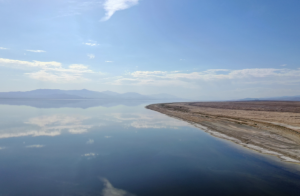
The electric vehicle revolution just got a big boost.
It came from this year’s Super Bowl ads, seven of which were for EVs.
U.S. automakers are all retooling their assembly lines to make EVs. That is a big deal because automakers and their suppliers make up the country’s largest manufacturing sector, comprising 3% of U.S. gross domestic product.
But their EV supply chains are all missing one critical link: battery-grade lithium.
Right now, all of the lithium that U.S. automakers use comes from outside the U.S., which could become a problem.
So American EV makers want to get their lithium from mines closer to home. And that could happen soon.
The Salton Sea to the Rescue
California has an abundance of geothermal energy resources and has been producing geothermal energy for decades.
The Salton Sea is one of these resources. Today, there are 11 geothermal power plants along the sea.
Under tremendous pressure, superheated brine flows to the surface. It immediately flashes to steam. This super-heated steam drives a turbine, which in turn drives an electric generator that’s connected to the grid.
Powerful pumps then inject the cooled brine back into the underground field. There, the brine is reheated.
And here’s the good news for EV makers: The brine is rich in minerals that contain lithium.
In fact, the sea holds more than enough lithium to make all the batteries American EV makers need. There could even be enough left over to export.
To top it all off, the electricity generated at the Salton Sea is carbon-free. That makes the lithium-extraction projects there “green.”
Largest Deposit in the World
California Gov. Gavin Newsom recently called the Salton Sea the “Saudi Arabia of lithium.”
And for good reason.
The U.S. Department of Energy believes the Salton Sea brine region could supply 600,000 tons of lithium annually. That’s more than the current U.S. demand. And some geochemists believe the field could hold 1 million to 6 million metric tons of lithium.
That would make it the largest lithium brine deposit in the world – big enough to potentially provide 50 to 100 years’ worth of lithium.
The biggest problem is figuring out how to extract that lithium from the brine. Scientists are also trying to figure out how much of the lithium is in the brine versus the surrounding rocks. That will determine how much lithium can be recovered.
And all of this has caught the attention of some big players.
Berkshire Hathaway Energy, a division of Berkshire Hathaway (NYSE: BRK.A), is working with the private company Controlled Thermal Resources to extract lithium from the cooled brine. Berkshire Hathaway Energy owns 10 of the 11 geothermal plants operating along the Salton Sea.
General Motors Company (NYSE: GM) is also invested in Controlled Thermal Resources. It’s one of the many American automakers that want to get their lithium from the Salton Sea.
Controlled Thermal Resources runs the Hell’s Kitchen Lithium and Power project. This is the first Salton Sea geothermal power plant to be combined with a lithium-extraction facility. And its pilot operation should be up and running in 2024.
(Here’s a short video explaining how it works.)
The company estimates the plant’s annual capacity will be around 300,000 tons once it’s fully constructed.
To put this into perspective, Controlled Thermal Resources CEO Rod Colwell says the annual worldwide production of lithium today is around 400,000 tons.
He indicated that the process can be easily replicated by just drilling more wells. And like every new technology, this one will get even better as engineers collect more data and refine the process.
Once Controlled Thermal Resources and others ramp up production at the Salton Sea, the U.S. will have its missing link in the critical EV supply chain.
Good investing,
Dave
